If you’re looking for a simple, plant-based recipe that packs of punch of savory, aromatic flavor, then this is the recipe for you – Za’atar Spiced Low FODMAP Tofu Scramble! This play on classic scrambled eggs uses tofu in place of eggs for a plant-powered, protein-rich twist. You might be thinking: “But…tofu doesn’t taste like eggs!” And you’d be right. But don’t worry – we got you.
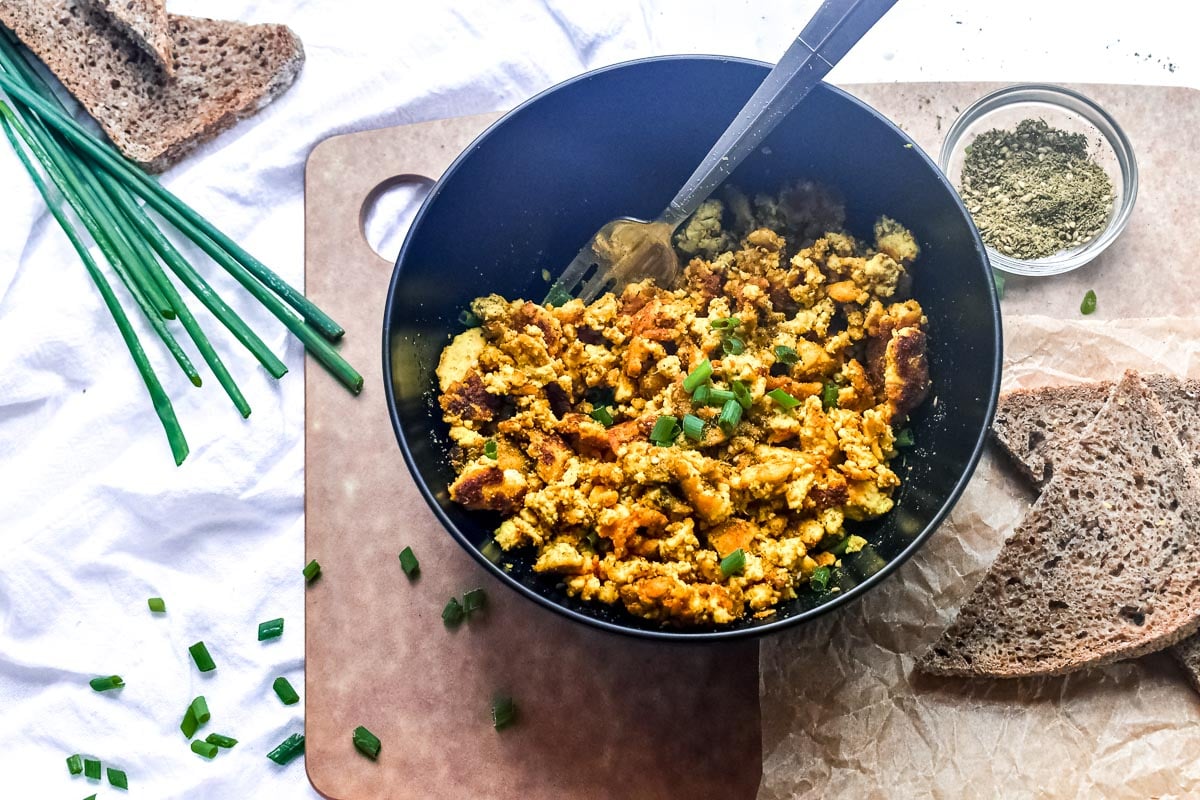
Best part: you’ll have a beautifully spiced, protein-packed, plant-based low FODMAP meal in under 15 minutes.
Tofu Scramble For Breakfast, Lunch Or Dinner
Eggs can be versatile and enjoyed at breakfast, brunch, lunch or dinner – and so can this Low FODMAP Tofu Scramble. Served with low FODMAP bread on the side, we like it at any time of day. Add a green salad to round it out, if you like.
Tofu Can Be Low FODMAP
Soy products can be confusing for the FODMAPer. Some soy products are low FODMAP, and some are not – and then there is tofu which is divided down the middle. Extra-firm and firm tofu (referred to as firm and plain on the Monash app) are low FODMAP. Soft and silken tofu are not low FODMAP. Medium has not been tested.
We use extra-firm or firm tofu in our low FODMAP recipes.
Please read our articles for general low FODMAP soy education:
The Low FODMAP Diet Is Not Dairy Free
While the low FODMAP diet is not dairy-free, we know that many of you are following a dairy-free lifestyle. I use rice milk in this recipe, which is not only dairy-free, but low FODMAP as well.
Monash University has lab tested rive milk and it is low FODMAP in ¾ cup (200 ml) portions.
Unusual Ingredients
You will notice that we include za’atar and kala namak in the ingredient list. You might not have heard of either one (or one or the other); we describe them in full down below.
Kala Namak, also referred to as black salt (it is one type of black salt), is a South Asian rock salt is known for its pungent, sulfuric flavor, and as you’ll soon see, a little goes on long way! Its signature smell comes from the salt’s volcanic origins, and it has been used in North and South Indian cooking for centuries. This flavor gem, combined with another low FODMAP allium alternative called asafetida, will pack your tofu scramble with a delicious and memorable eggy punch, minus the eggs.
Our tofu scramble uses this delicious, one-of-a-kind “secret ingredient” that will give any plant-based meal that eggy, sulfuric note that you’d recognize from your favorite scrambled egg dish.
Kala Namak has not been lab tested for FODMAPs. The nutrition label contains no carbohydrates per serving size of ¼ teaspoon, therefore we consider it low FODMAP.
We’ll also show you how to make a zesty, herbaceous, and quintessential spice blend commonly used throughout North Africa and the Arabian Peninsula, called za’atar. It’s a combination of cumin, sesame seeds, sumac, red pepper flakes, ground coriander, dried thyme, and salt – and all of these individual ingredients are low FODMAP.
This particular za’atar recipe is one that my Cypriot family uses often at home, and it’s a perfect addition on, well, almost everything! Here, we’ll sprinkle it on top of our scramble, for a fresh, bright, complex flavor-note on top of an already-delicious dish.
Making Scrambled Tofu

Make Za’atar: In a small bowl stir together the coriander, cumin, sesame seeds, sumac, thyme, red pepper flakes and salt.
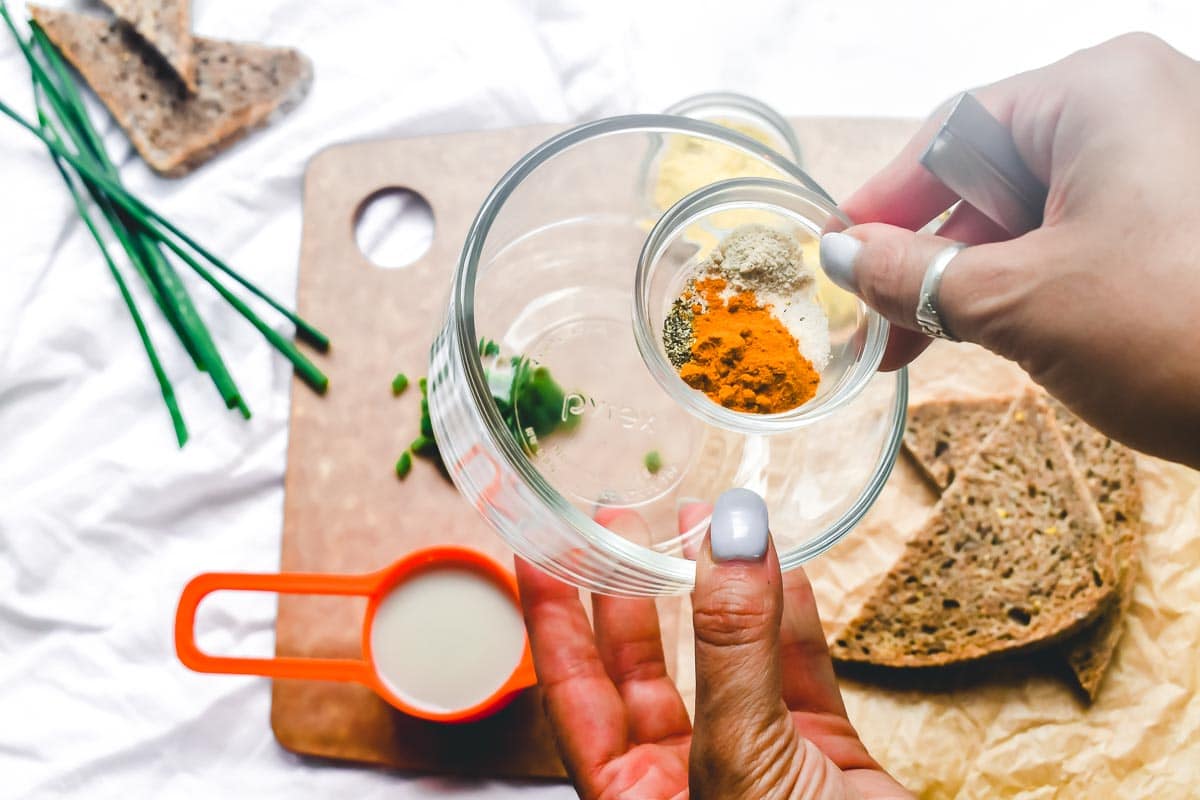
To bring out maximum flavor and aroma from the spice mix, you have the option to add your za’atar spice mixture to a small, heated frying pan to toast the mixture for about 1 minute (or until aromatic – do not add oil). Be careful not to burn the spices. Cool. You can use right away or store in an airtight container for future use; you will only be using a tiny bit for this recipe.
For the Tofu Scramble: Place tofu in a small mixing bowl. Using the back of a fork, mash the tofu into a fairly even consistency.
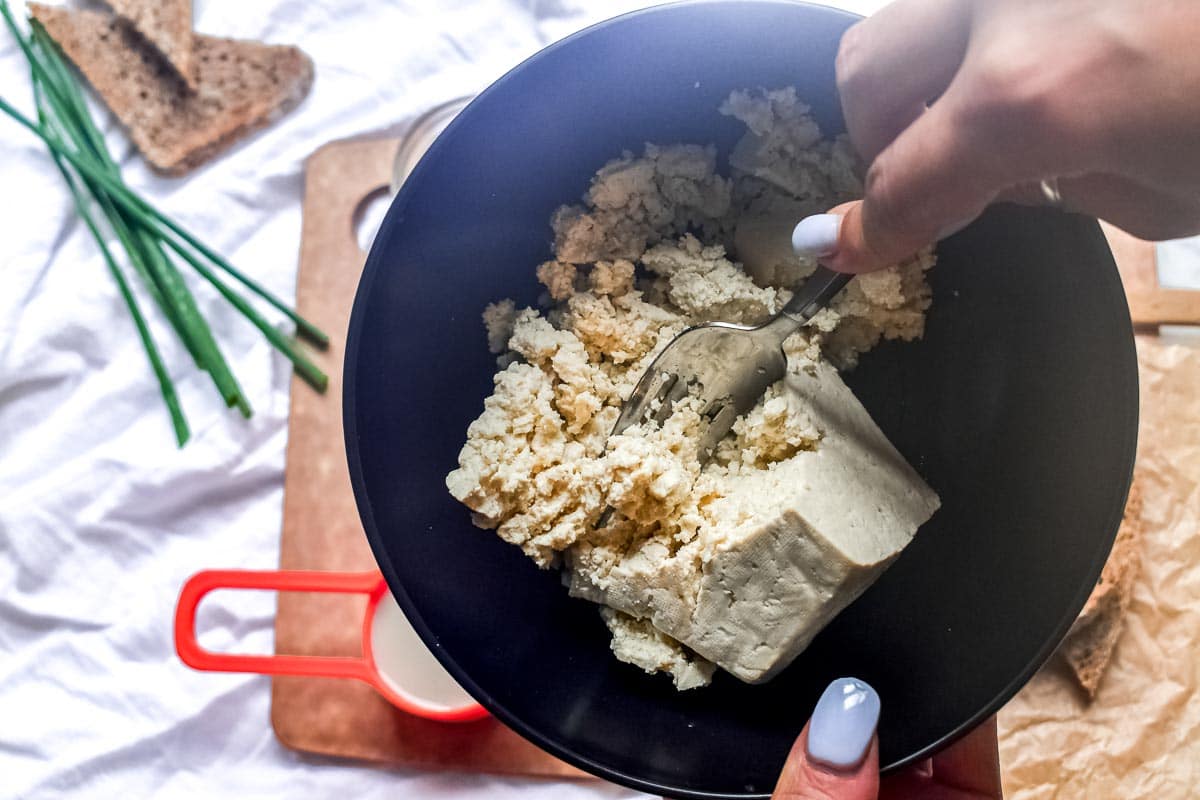
Don’t overdo it! Leave some big chunks, and don’t worry too much about the moisture. This will cook out.
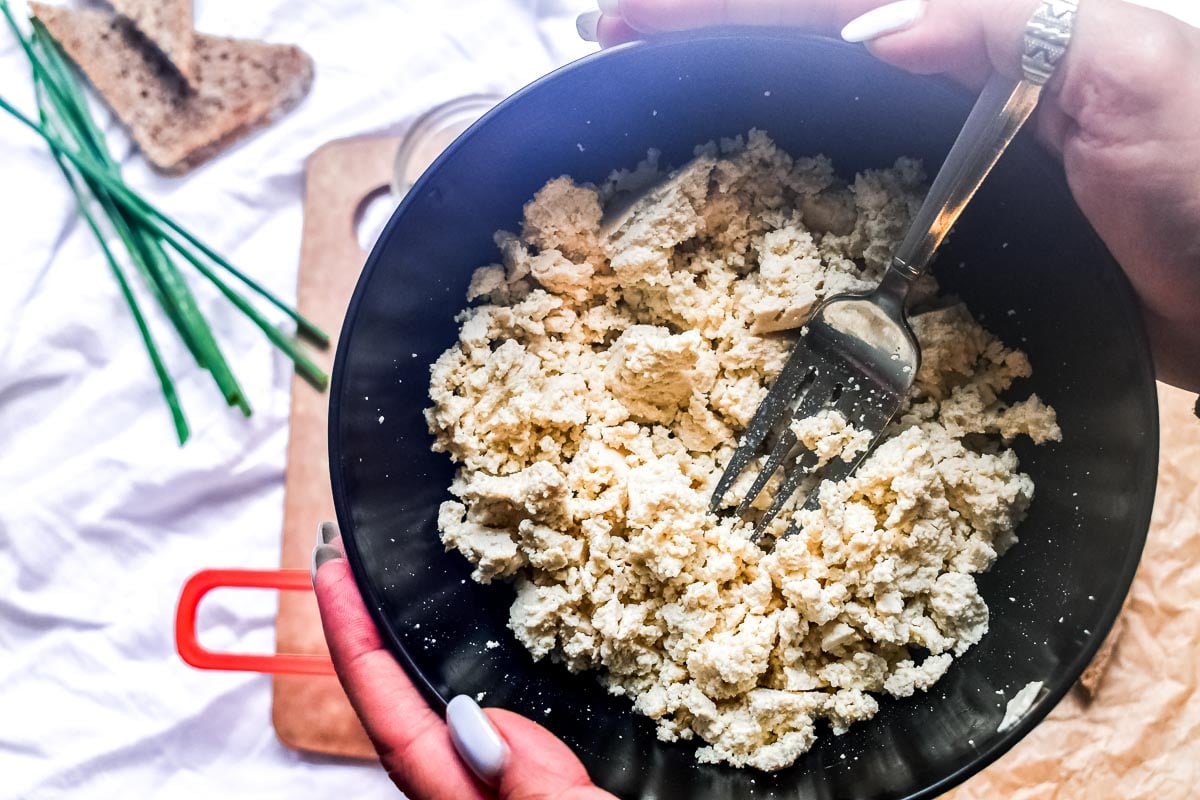
In a separate bowl, whisk together the nutritional yeast, Dijon mustard turmeric and black salt.
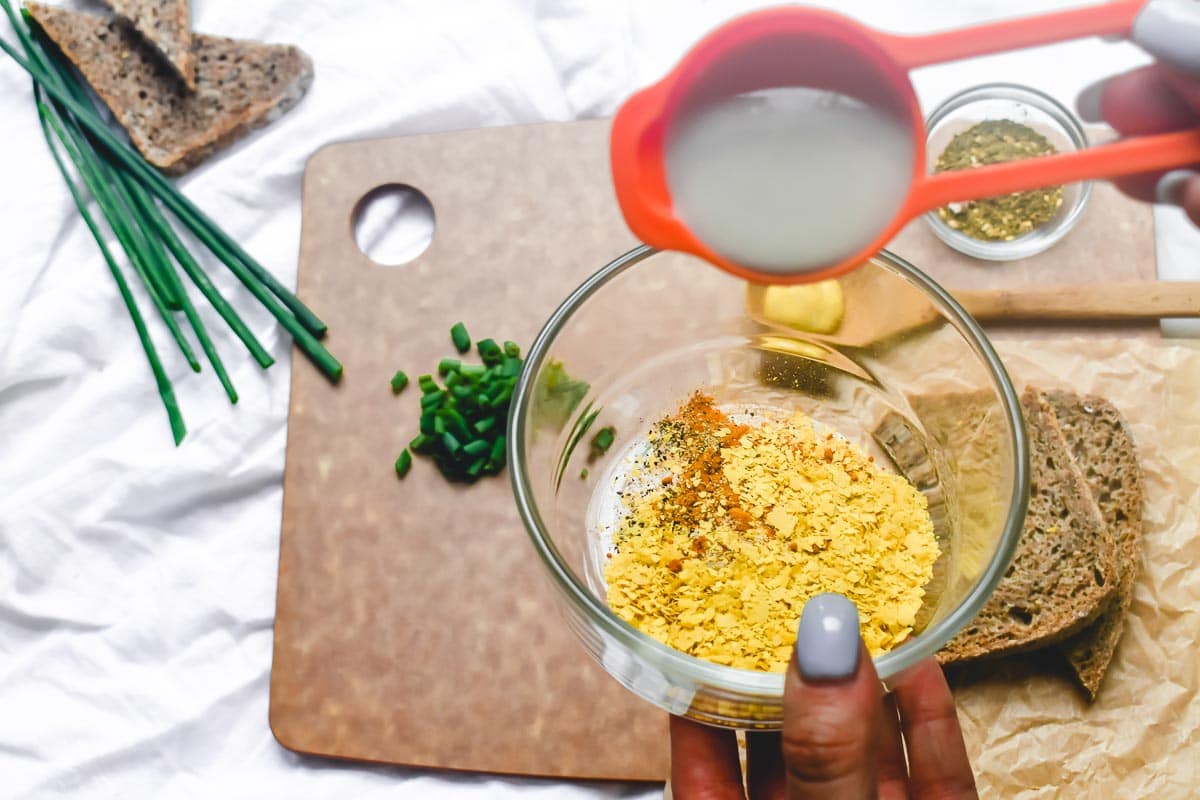
Slowly add in the rice milk and whisk until well incorporated. Set aside.
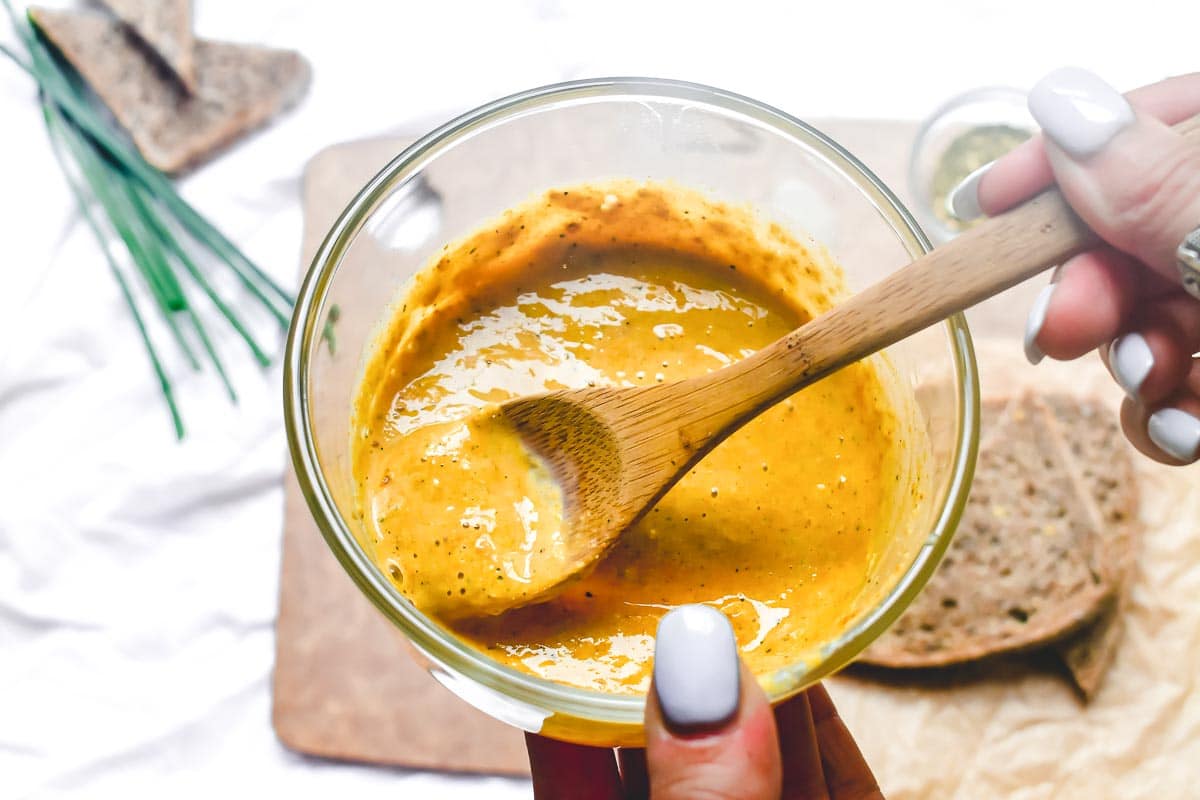
Heat skillet over medium heat, add oil and heat until shimmering. Add the asafetida into the heated oil and stir until fragrant, about 30 seconds.
Add your mashed tofu into the oil and asafetida on your pan.
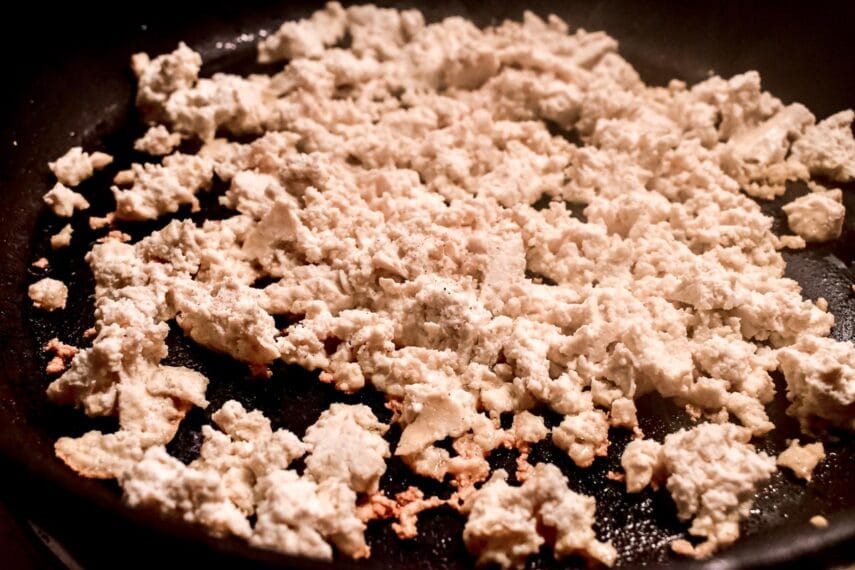
Mix well until evenly dispersed. Allow the tofu to cook undisturbed in the oil until most of the moisture has cooked out and the tofu begins to brown slightly, about 5 minutes.
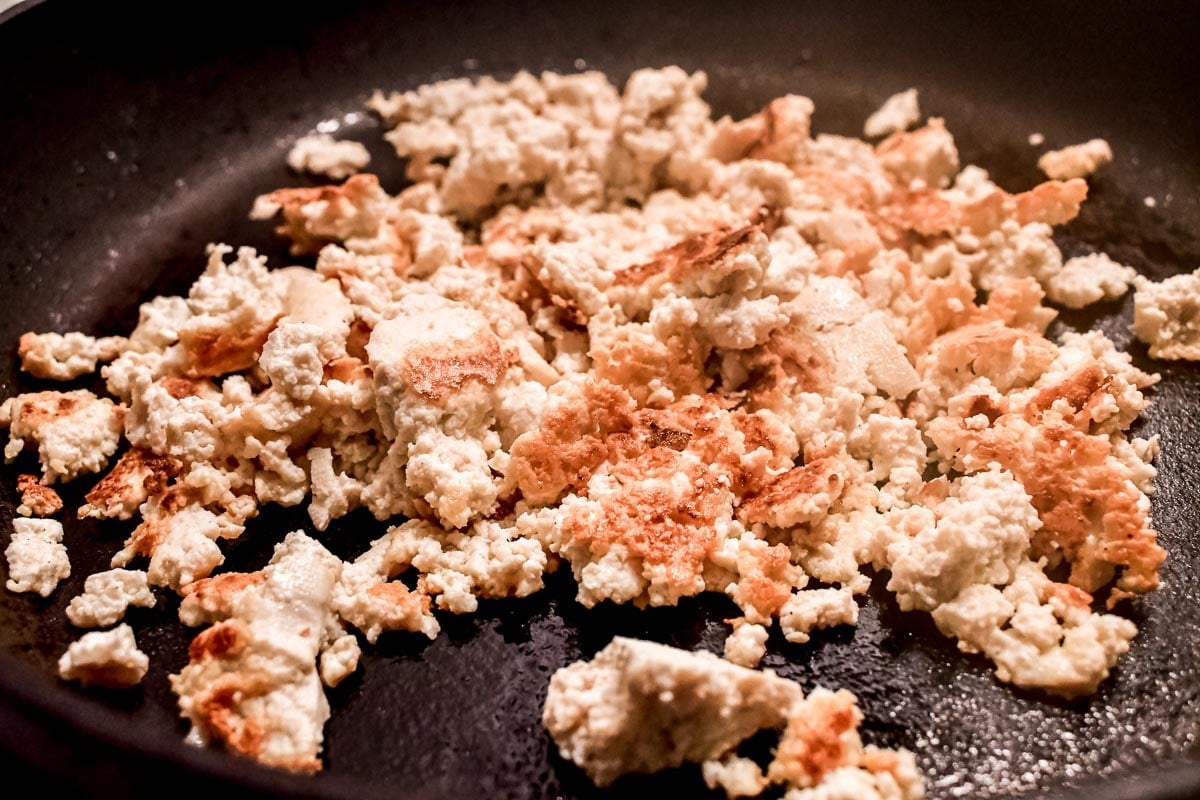
Once the tofu has browned just slightly, add your nutritional yeast/rice milk mixture.
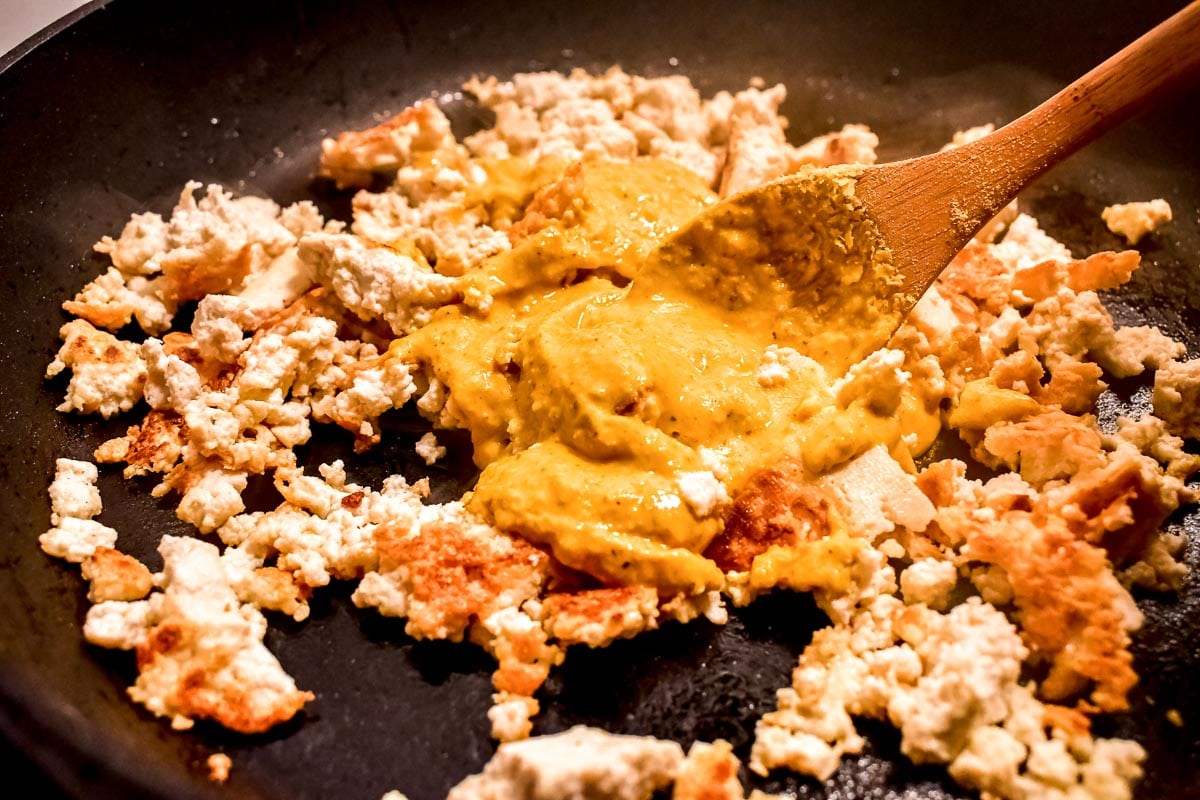
Stir well into the tofu mash and increase heat to medium high. Allow your tofu scramble to cook until it achieves your desired consistency.
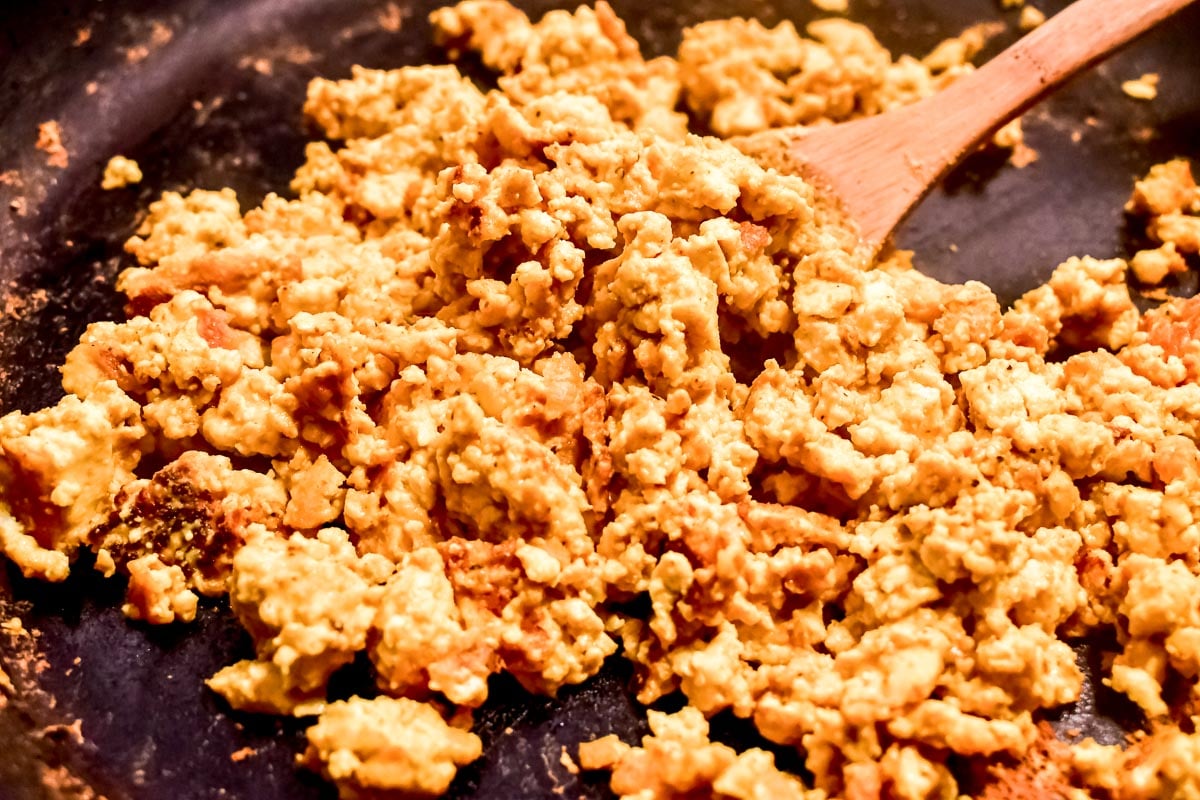
For a “runnier” tofu scramble, you will need less cooking time, about 3 to 5 minutes. For a fluffier, well-cooked tofu scramble, you will need more time, about 5 to 7 minutes).
Scoop tofu scramble onto a plate, top with chopped chives, black pepper, and a pinch or two of your za’atar seasoning.
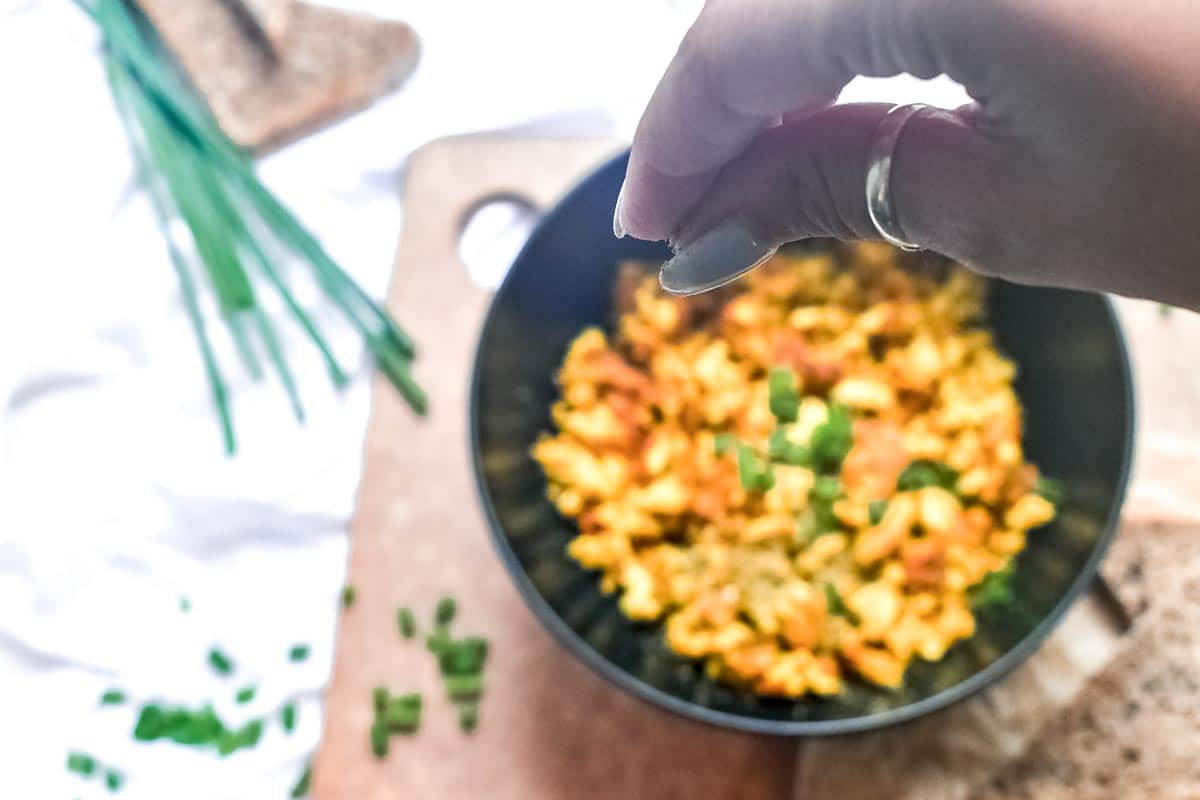
Enjoy with your favorite low FODMAP toast.
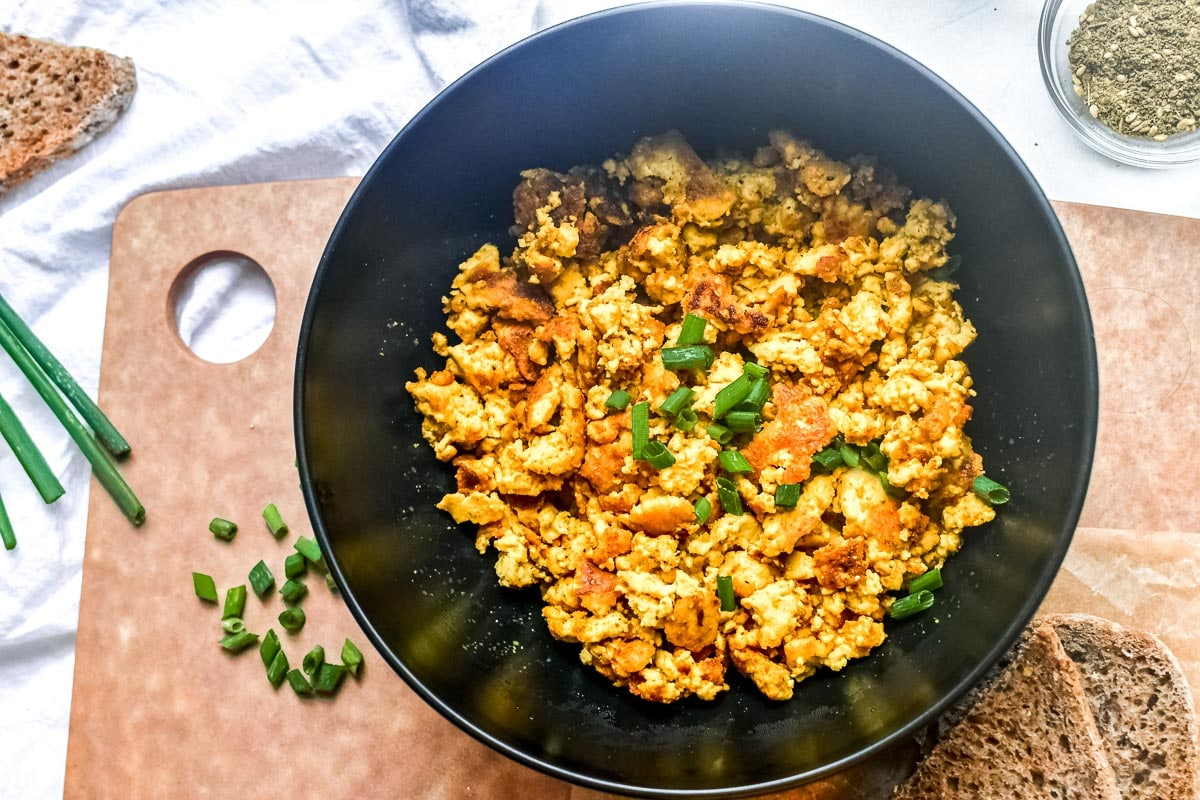
FODMAP Information
Our recipes are based on Monash University and FODMAP Friendly science.
- Chives: Both Monash University and FODMAP Friendly have lab tested chives. Monash says that chives contain no FODMAPs. FODMAP Friendly gives them a “Pass” at 1 tablespoon (4 g).
- Oil: All pure oils are fats and contain no carbohydrates, therefore they contain no FODMAPs.
- Rice Milk: Both Monash University and FODMAP Friendly have lab tested rice milk. Monash University deems a low FODMAP serving of rice milk to be ¾ cup (200 ml). FODMAP Friendly gives rice milk a “PASS” at 8-ounces (250 ml) amounts.
Please always refer to the Monash University & FODMAP Friendly smartphone apps for the most up-to-date lab tested information. As always, your tolerance is what counts; please eat accordingly. The ultimate goal of the low FODMAP diet is to eat as broadly as possible, without triggering symptoms, for the healthiest microbiome.
Looking for vegetarian breakfasts? Check out this article, with our favorites.
And for more plant-forward recipes in general, check out Plant Power: 31 Low FODMAP Vegan and Plant-Based Recipes.
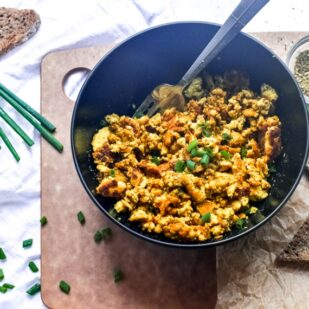
Za’atar Spiced Low FODMAP Tofu Scramble
If you’re looking for a simple, plant-based breakfast recipe that packs of punch of savory, aromatic flavor, then this is the recipe for you! This play on classic scrambled eggs uses tofu in place of eggs for a plant-powered, protein-rich twist. You might be thinking: “But…tofu doesn’t taste like eggs!” And you’d be right. But don’t worry – we got you.
Ingredients:
Za’atar Seasoning:
- 1 teaspoon ground coriander
- 1 teaspoon ground cumin
- 1 teaspoon sesame seeds
- 1 teaspoon sumac
- 1 teaspoon dried thyme
- ¼ teaspoon red pepper flakes
- ¼ teaspoon salt
Tofu Scramble:
- 7- ounces (200 g) firm tofu
- ¼ cup nutritional yeast, preferably Bragg’s
- 1 teaspoon Dijon mustard
- ½ teaspoon turmeric
- ¼ teaspoon black salt
- 1/3 cup (75 ml) unsweetened rice milk
- 1 teaspoon avocado oil
- ¼ teaspoon asafetida; use gluten-free if following a gluten-free diet
- 2 tablespoons chopped chives
- 1/4 teaspoon black pepper
- 2 slices low FODMAP bread or toast; I used whole wheat. Use vegan bread if desired
Preparation:
-
Make Za’atar: In a small bowl stir together the coriander, cumin, sesame seeds, sumac, thyme, red pepper flakes and salt. To bring out maximum flavor and aroma from the spice mix, you have the option to add your za’atar spice mixture to a small, heated frying pan to toast the mixture for about 1 minute (or until aromatic – do not add oil). Be careful not to burn the spices. Cool. You can use right away or store in an airtight container for future use; you will only be using a tiny bit for this recipe.
-
For the Tofu Scramble: Place tofu in a small mixing bowl. Using the back of a fork, mash the tofu into a fairly even consistency. Don’t overdo it! Leave some big chunks, and don’t worry too much about the moisture. This will cook out.
-
In a separate bowl, whisk together the nutritional yeast, Dijon mustard, turmeric and black salt. Slowly add in the rice milk and whisk until well incorporated. Set aside.
-
Heat skillet over medium heat, add oil and heat until shimmering. Add the asafetida into the heated oil and stir until fragrant, about 30 seconds.
-
Add your mashed tofu into the oil and asafetida on your pan. Mix well until evenly dispersed. Allow the tofu to cook undisturbed in the oil until most of the moisture has cooked out and the tofu begins to brown slightly, about 5 minutes. Once the tofu has browned just slightly, add your nutritional yeast/rice milk mixture. Stir well into the tofu mash and increase heat to medium high. Allow your tofu scramble to cook until it achieves your desired consistency. For a “runnier” tofu scramble, you will need less cooking time, about 3 to 5 minutes. For a fluffier, well-cooked tofu scramble, you will need more time, about 5 to 7 minutes).
-
Scoop tofu scramble onto a plate, top with chopped chives, black pepper, and a pinch or two of your za’atar seasoning. Enjoy with your favorite low FODMAP toast.
Notes:
- It is crucial to cook the asafetida in a small amount of oil before adding the remainder of your ingredients to the pan. Remember that this delicious, low FODMAP allium alternative is quite pungent. Toasting the spice in oil allows for an aroma to come through, and some of the sharpness to be tempered.
- If you don’t use all of your za’atar, that’s okay! Store it in an airtight spice container and try it out again whenever you’re looking for a low FODMAP spice kick.
- If you are vegan, make sure your bread is, too.
FODMAP Information
Our recipes are based on Monash University and FODMAP Friendly science.
• Chives: Both Monash University and FODMAP Friendly have lab tested chives. Monash says that chives contain no FODMAPs. FODMAP Friendly gives them a “Pass” at 1 tablespoon (4 g).
• Oil: All pure oils are fats and contain no carbohydrates, therefore they contain no FODMAPs.
• Rice Milk: Both Monash University and FODMAP Friendly have lab tested rice milk. Monash University deems a low FODMAP serving of rice milk to be ¾ cup (200 ml). FODMAP Friendly gives rice milk a “PASS” at 8-ounces (250 ml) amounts.
Please always refer to the Monash University & FODMAP Friendly smartphone apps for the most up-to-date lab tested information. As always, your tolerance is what counts; please eat accordingly. The ultimate goal of the low FODMAP diet is to eat as broadly as possible, without triggering symptoms, for the healthiest microbiome.
Nutrition
All nutritional information is based on third-party calculations and should be considered estimates. Actual nutritional content will vary with brands used, measuring methods, portion sizes and more. For a more detailed explanation, please read our article Understanding The Nutrition Panel Within Our Recipes.
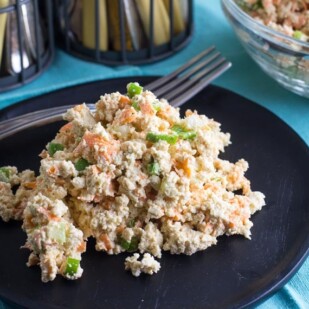
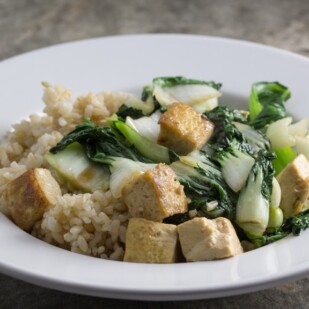






Loved the z’atar scrambled tofu. I added 3 leaves if chopped dino kale that I sauteed pre tofu. It was delicious.i didn’t need salt with Dijon and kala namak.
Thanks for sharing.
OH great tweak! Thank you for letting us know.